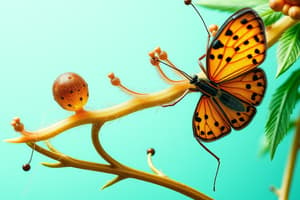Podcast
Questions and Answers
How do you know if something is alive? Describe some of the characteristics of living things.
How do you know if something is alive? Describe some of the characteristics of living things.
You can know by the order, sensitivity or response to the environment, reproduction, adaptation, growth and development, homeostasis, energy processing, and evolution.
What do humans, plants and mushrooms have in common?
What do humans, plants and mushrooms have in common?
They all grow, they're all living.
What do you see after focusing the microscope sample?
What do you see after focusing the microscope sample?
I see hexagonal cells with a green cellular wall.
What do you see when you select the 400x magnification?
What do you see when you select the 400x magnification?
Match the description with the microscope part on the diagram.
Match the description with the microscope part on the diagram.
Which focus knob is easier to use at 40x? 400x?
Which focus knob is easier to use at 40x? 400x?
What structures can you see in human skin cells?
What structures can you see in human skin cells?
Using the scale bar, about how wide is a human skin cell?
Using the scale bar, about how wide is a human skin cell?
List the organelles and approximate size of the cells in each sample.
List the organelles and approximate size of the cells in each sample.
What do all of these samples have in common?
What do all of these samples have in common?
What is the approximate size of E. coli?
What is the approximate size of E. coli?
What organelles are present in E. coli?
What organelles are present in E. coli?
What organelle is missing from E. coli?
What organelle is missing from E. coli?
Does sand/silt have any internal structures?
Does sand/silt have any internal structures?
Do you think sand or silt is alive? Explain.
Do you think sand or silt is alive? Explain.
Collect data: Use the microscope to observe the samples listed in the table below. For each sample, estimate the cell size and check off the organelles that are present.
Collect data: Use the microscope to observe the samples listed in the table below. For each sample, estimate the cell size and check off the organelles that are present.
What is the function of the nucleus?
What is the function of the nucleus?
What is the function of the cytoplasm?
What is the function of the cytoplasm?
What is the function of the cell membrane?
What is the function of the cell membrane?
What is the function of the axon?
What is the function of the axon?
What is the function of a dendrite?
What is the function of a dendrite?
What do muscle cells have that other cell types do not?
What do muscle cells have that other cell types do not?
What is a striation and how does it help muscle cells function?
What is a striation and how does it help muscle cells function?
What is the function of red blood cells?
What is the function of red blood cells?
What is the function of white blood cells?
What is the function of white blood cells?
What organelle is missing from the red blood cells?
What organelle is missing from the red blood cells?
In general, are there any major differences that you can see? Explain.
In general, are there any major differences that you can see? Explain.
What organelle do frog RBCs have that human RBCs do not?
What organelle do frog RBCs have that human RBCs do not?
Describe how skin cells, neurons, muscle cells, and blood cells relate to the functions of skin, nerve, muscle, and blood tissue.
Describe how skin cells, neurons, muscle cells, and blood cells relate to the functions of skin, nerve, muscle, and blood tissue.
What structures do all of these cells have in common?
What structures do all of these cells have in common?
What structures are missing from the root hair cells?
What structures are missing from the root hair cells?
Why is the chloroplast missing from the root hair cell?
Why is the chloroplast missing from the root hair cell?
How are the algae cells different from the other cells?
How are the algae cells different from the other cells?
Which other samples in the Gizmo do you think represent unicellular organisms?
Which other samples in the Gizmo do you think represent unicellular organisms?
What structures allow each protist to move?
What structures allow each protist to move?
What is the photosynthetic protist and how do you know?
What is the photosynthetic protist and how do you know?
Find two structures that help E. coli move and describe them.
Find two structures that help E. coli move and describe them.
Do protists (Amoeba, Euglena, Paramecium) use similar structures to move? Explain.
Do protists (Amoeba, Euglena, Paramecium) use similar structures to move? Explain.
What happens when you click Play?
What happens when you click Play?
Does the worm neuron sample produce ATP?
Does the worm neuron sample produce ATP?
How do you know that the worm neuron sample produces ATP?
How do you know that the worm neuron sample produces ATP?
What happens to the phenol red?
What happens to the phenol red?
When CO2 combines with water it forms carbonic acid. How does this explain the phenol red result?
When CO2 combines with water it forms carbonic acid. How does this explain the phenol red result?
Based on the test results, are the worm neurons alive?
Based on the test results, are the worm neurons alive?
When observing the phenol red, what happens?
When observing the phenol red, what happens?
What happens when you run the experiment in the dark?
What happens when you run the experiment in the dark?
Based on the test results, are maple leaves alive?
Based on the test results, are maple leaves alive?
Collect data: Using the table below, select the sample on the LANDSCAPE tab. Perform the experiment in the light.
Collect data: Using the table below, select the sample on the LANDSCAPE tab. Perform the experiment in the light.
Which of the samples in the table are alive?
Which of the samples in the table are alive?
How do you know the samples are alive?
How do you know the samples are alive?
Which samples from the table are likely to undergo photosynthesis?
Which samples from the table are likely to undergo photosynthesis?
How do you know which samples undergo photosynthesis?
How do you know which samples undergo photosynthesis?
Is silt alive?
Is silt alive?
How do you know silt is not alive?
How do you know silt is not alive?
Flashcards are hidden until you start studying
Study Notes
Characteristics of Living Things
- Defined by order, sensitivity to the environment, reproduction, adaptation, growth, development, homeostasis, energy processing, and evolution.
- Organisms like humans, plants, and mushrooms exhibit these characteristics, confirming they are alive.
Microscopy Observations
- Coarse and fine focus adjustments used to view hexagonal cells with green walls and chloroplasts.
- Structures visible in human skin cells include the nucleus, cell membrane, and cytoplasm.
- Human skin cells estimated width is about 30 micrometers using a scale bar of 20 micrometers.
Cell Organelles and Types
- Common organelles across samples: nucleus, cell membrane, cytoplasm.
- E. coli lacks a nucleus but has a cell wall, membrane, cytoplasm, flagellum, pilus, and nucleoid.
- Notable differences in red blood cells between humans (non-nucleated) and frogs (nucleated).
Functions of Cell Structures
- Nucleus: Contains DNA and regulates gene expression.
- Cytoplasm: Gel-like substance housing organelles, predominantly composed of water.
- Cell Membrane: Lipid bilayer providing protection and regulating substances entering/leaving the cell.
Neural and Muscle Cell Functions
- Neurons transmit signals through axons and dendrites; dendrites convert signals into impulses toward the cell body.
- Muscle cells contain multiple nuclei and exhibit striations for force generation and contraction.
Blood Cell Functions
- Red blood cells transport oxygen; white blood cells protect against disease.
- Structures in red blood cells differentiate significantly between species.
Tissue Organization
- Cells group into tissues with specific functions; skin cells, neurons, muscle cells, and blood cells contribute to their respective tissues.
Protists and Movement
- Protists like amoeba (pseudopodium), euglena (flagellum), and paramecium (cilia) use distinct structures for movement.
- Euglena is photosynthetic, identifiable by its chloroplasts.
Experiment Observations and Results
- ATP positive controls glow green, indicating ATP presence; phenol red turning orange implies CO2 presence from metabolism.
- Samples including E. coli, fungi, human skin, maple leaves, root hair, and protists confirmed alive based on respiration and ATP production.
Photosynthesis
- Identified potential photosynthetic organisms among tested samples: maple leaves and protists due to respiration absence in light.
- Sand/silt confirmed as non-living due to lack of respiration and ATP production.
Studying That Suits You
Use AI to generate personalized quizzes and flashcards to suit your learning preferences.





